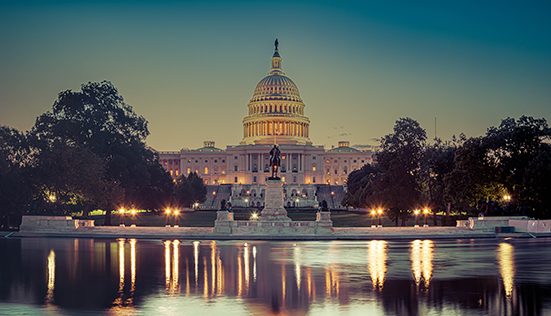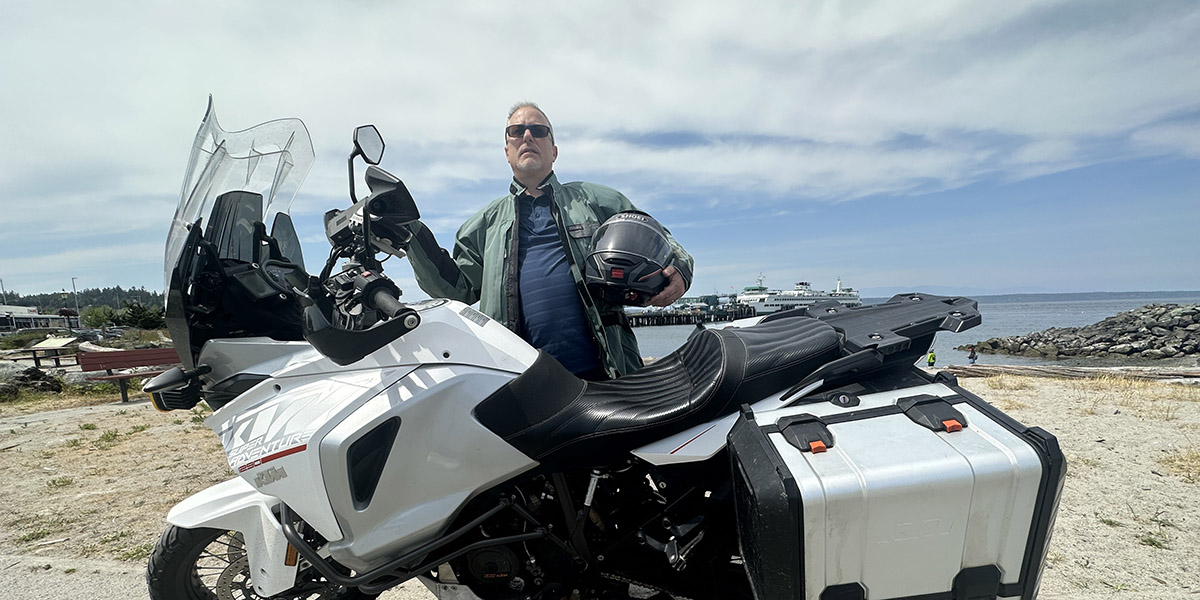Spend a few questions with the newly appointed — but longtime AMA employee and motorcyclist — Government Relations Director Nick Haris
September 6, 2023 (Story from August edition of American Motorcyclist)
By Keaton Maisano
In May, the AMA announced the restructuring of its Government Relations Department to better serve its members throughout the country.
Focusing on improved engagement by dividing the country into regions, the AMA added Central states and Eastern states representatives to the mix. Federal issues will be handled by a new Washington representative position to be hired in the Washington, D.C., office. Nick Haris remains the Western states representative, while also elevating into the role of government relations director.
Recently returning to Seattle (where he grew up) after more than two decades in California, Haris has had his finger on the pulse of motorcycling issues on the West Coast since his arrival at the AMA in the late 1990s. Add a seasoned motorcycling history that has involved owning 21 motorcycles, and it is easy to see why Haris — who continues to be a serious rider and member of the motorcycling community — is the right man to spearhead the new direction for the AMA Government Relations Department.
AM: Tell us about your first bike and your early riding experiences?
NH: I got my first bike — a 1988 Yamaha YSR50 — when I was 16, and only recently sold it. I used it to commute to high school and occasionally rode it to the University of Washington during college.
No one in my immediate family rode, and although I don’t remember it, I’ve heard stories about my first time on a bike. I was about 10 years old and went with a friend to see some of his extended family. They had a small Briggs & Stratton-powered minibike and sent the kids out to a nearby field to try it out. They could hardly get me off it, and after each ride I got back in line until I was the only kid left still wanting to ride. I was clearly obsessed, and my parents said it was all I wanted to talk about for weeks.
I was also a fanatical bicycle rider for much of my younger years, both BMX and road bikes. I think the attraction was the same…freedom. We used to do some pretty crazy things in local parks etc.
My first extended trip on a motorcycle was in 1998 when I took my ’81 H-D FXWG to and from Portland for a memorial ride. It was just under 500 miles for the day, and I remember feeling like I had done something significant. The trip really showed me the comradery amongst riders and made me want to be a part of the community.
It also made me realize I had a lot to learn about longer rides. I was tired when I got home despite having really enjoyed the ride, and it started my interest in longer trips and travel. That ultimately led to me riding from New Orleans to California via Sturgis in 2002, a total of 4,000 miles in 10 days.
AM: What was your first job in the motorcycle industry?
NH: I worked at Fast Company in Kirkland, Wash., which sold CMC, Bourget and Panzer motorcycles before becoming an Indian franchise in the late 1990s. Basically, we sold American V-Twin (Harley clones) and had a well-known performance/service department. I ran the office, handled the website, payroll and financing. I had always wanted to work in the industry and when I saw the job advertised, I grabbed the opportunity. I took great pride in being the employee with the longest commute and won a shop contest for most days in a row ridden to work, Seattle not being exactly warm or dry for much of the year.
AM: How did you get into activism?
NH: I grew up in a politically active family. My mother was on the Seattle Park Board and School Board, so I spent lots of time passing out voter information and knocking on doors in my youth. I also went to many election-night events as a youngster with my mother, and learned how important it is to get involved and how — at the end of the day — most elections are won by the candidate that can turn out local supporters.
This background proved beneficial when I joined the AMA staff in 2001, primarily to support its government relations efforts. I was already an AMA member, and despite being a fan of all forms of motorcycle racing, I was always drawn to the government relations stories and felt a real admiration for those people who were working to protect riding. With my love of motorcycles, coupled with my economics degree, it seemed like a natural fit.
AM: How have you seen effective government relations strategies change over the years?
NH: The ability of citizens to engage with elected officials has changed in large part due to the popularity and acceptance of remote options such as Zoom and Teams. Likewise, the use of social media to get the word out has become not only accepted but also very effective.
However, bureaucracy and government in general are pretty stagnant, and despite new communications strategies I think the way they operate and make decisions hasn’t really changed. The old saying is, “decisions are made by those that show up,” and that remains true in my mind, but the ways in which you can show up have been evolving thanks to these remote options.
AM: On the contrary, what has stayed the same?
NH: Nothing beats one-on-one meetings and personal relationships with decision makers. Once you’ve established yourself as a reliable, credible voice for your issues, it is easier to stay engaged, but the old tried-and-true methods of in-person relationships will always be critical.
I like to say the time to get to know a decision maker is before you need something…so take the opportunity to go to a meet and greet at the local coffee shop. Get to know the staff, as well. They have a difficult job to do, and if they know they can reach out when they have a question or need support, you will become the go to on issues that are important to you.
AM: How has grassroots advocacy in the motorcycling community evolved?
NH: The level of professionalism in the grassroots community has always been a source of strength. The willingness of volunteers to step up, and in many cases be the leaders on emerging issues, is critical to our success as an organization, and benefits the entire riding community. After all, the AMA’s strength is in its members, whose ability to engage with their elected officials is critical. It facilitates GRD staff’s ability to gain access to those same decision makers, who know we speak for their constituents (voters). Members are often the first people to hear about an issue and then bring it to our attention.
Some of the changes I see in how grassroots advocacy has evolved include: the use of social media; citizen journalism; popularity of podcasts/blogs/forums; and the sharing of information and strategy between different groups/states etc., which has proven to be very useful.
The AMA makes use of many of these newer grassroots advocacy tools. For example, when members sign up for government relations communications such as News and Notes and Action Alerts, they can stay informed about issues we see in other regions and be better prepared to respond if/when similar ones arise in their home states.
Long gone are the days when members only have the options of sending a letter by mail or showing up in person to make their voices heard. Our ability to quickly respond and communicate with decision makers is critical. By taking the time to send a message or make a phone call, our members let decision makers know they are engaged and paying attention to the issues under consideration.
A recent example: In January of this year a bill (Looney SB 96) was introduced that would have made riders that chose to ride in Connecticut without a helmet (legal under existing state law) mandatory organ donors. The AMA quickly responded by sending member alerts, contacting the sponsor and engaging with organizations that work on this issue (none of whom supported the proposal to make it mandatory). The bill was quickly shelved.
Sadly, this was not the first time the AMA had fought such an offensive proposal. In 2003, a similar bill was introduced in New Mexico, but thanks to our membership making their voices heard, it was quickly defeated.
AM: What role does social media play in both engagement and raising awareness of important issues?
NH: Social media can be a double-edged sword. Often in a rush to be “first,” incomplete or incorrect information can cause unneeded alarm or require a response that takes up time that could otherwise be used to address the actual issue.
Social media is of course a great way to get the word out quickly and to a broad audience. Tailoring the message to best serve the consumers of the specific platform is also essential. If a quick, easily understood and accurate message can draw the reader/viewer in, then a more comprehensive and nuanced message can be presented, but few people these days want to read a three-page story on an issue they are just becoming aware of.
Coordination of message, correct timing and multiple channels of communication are all critical and evolving constantly.
AM: What are issues you see becoming larger in the next 5 years?
NH: Two issues stick out in my mind: automated vehicles and the rush towards an electric vehicle future.
As the push towards automated vehicles continues, it is critical that any of the self-driving technologies being introduced on our nation’s roadways are required to recognize and react properly when they encounter a motorcycle or similar smaller vehicle. The AMA has been fighting for this perspective for nearly a decade, and we also work with our European counterparts on this significant issue. The question isn’t if but when we will see fully autonomous vehicles on the road, and while the potential safety benefits are interesting, the bottom line is they are not yet ready — or safe — for widespread use.
The rush towards an electric vehicle future must acknowledge the current reality that we simply don’t have adequate infrastructure to provide access to charging facilities for millions of vehicles. Charging times, equipment compatibility and battery technology are improving, and given enough time I think they will be able to meet demand (especially with uniform chargers), but access to e10 and fossil fuels in general are clearly going to remain a priority for the AMA and the motorized community in general.
Likewise, the ability to have enough range to allow riders to travel significant distances remains a real concern.
AM: How can the AMA guide members on which issues are important at the state level, such as lane splitting…or the federal level, such as automated vehicles?
NH: The AMA’s Board of Directors Position Statements are a great resource. Rather than let a third party tell you what our position is on an issue, it is always best to go to the source. Along with the official AMA position, many of the statements include source material references that further help to describe and explain the reasoning behind a particular decision to support or oppose legislative proposals.
For example, while the AMA supports efforts to introduce lane filtering or splitting legislation, we are unwilling to trade one right for another, such as mandatory medical insurance above and beyond what is already required. Our board is comprised of industry veterans and enthusiasts who bring decades of first-hand experience with the many issues facing motorcycling.
Likewise, the AMA has direct experience dealing with numerous legislative and regulatory challenges. This background, coupled with our members’ enthusiasm and passion for all things motorcycle, gives us the unique ability to successfully work for the benefit of motorcyclists nationwide. Coupled with our longstanding relationships with numerous other likeminded organizations, the AMA is uniquely positioned to effectively guide grassroots enthusiasts and help them to tell their unique stories to key decision makers.
Adding regional representatives to our team, as well as a Washington D.C., representative to handle federal issues, will also be key in doing an even better job at guiding our members on which issues are the most important to them.
AM: How will the new regional structure improve the way the AMA engages with legislators and organizations at all levels of government, as well as with members?
NH: Regional representation will make a difference. Local knowledge and connections are crucial for effective advocacy and lobbying. These team members will have the pulse of the political and social landscapes of their states, and will work with key decision makers and influencers in their regions. Their personal networks will be strong, and they will understand how to work well with state and local partners and stakeholders.
Our members are critical partners in any outreach efforts. Frankly, this type of work is difficult to do from any single location. Having staff sited where the laws are made and affected and where motorcyclists ride will allow us to both engage with policy makers to shape the discussion as well as react to proposals in a more timely and relevant way. This has worked for me in the Western states, and it will succeed in the Central and Eastern ones, too.
The AMA’s mission to promote the motorcycle lifestyle and protect its future remains at the forefront of any decision, and Nick Haris — a seasoned rider with a 22-year history of advocacy with the AMA — is the right man to lead the AMA Government Relations Department into a new era of improved advocacy and protection.
With Haris setting a strong example at the top, the reimagined department will be in tune with important issues throughout the country, and be better equipped to stand up for the motorcycling community now and into its bright future.






